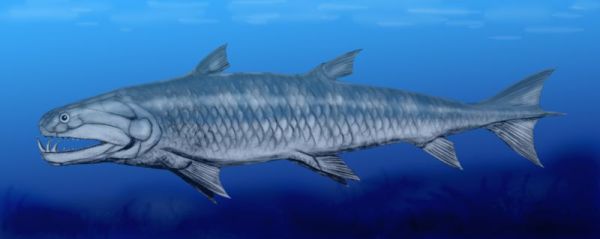
Onychodus sigmoides, from the Late Devonian of North America. Artwork by Nobu Tamura, 2008. Wikipedia, GNU Free Documentation/Creative Commons Attribution license.
| Sarcopterygii | ||
| The Vertebrates | Onychodontiformes |
| Vertebrates Home | Vertebrate | Vertebrate |
|
Abbreviated Dendrogram
Teleostomi
├─Neopterygii
└─Sarcopterygii
├─┬─Onychodontiformes
│ │ ├─Onychodus
│ │ └─Strunius
│ └─Actinistia
└─Rhipidistia
├─Dipnomorpha
└─┬─Rhizodontiformes
└─Osteolepiformes
├─Tristichopteridae
└─Elpistostegalia
├─Panderichthys
└─Tetrapoda
|
Contents
Overview |
 Onychodus sigmoides, from the Late Devonian of North America. Artwork by Nobu Tamura, 2008. Wikipedia, GNU Free Documentation/Creative Commons Attribution license. |
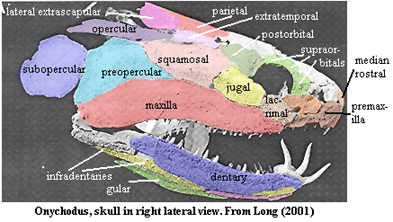 Onychodontiformes: = Onychodontida = Onychodontidae, etc.) Onychodus, Strunius. Quebecius is still sometimes listed among the onychodontiforms, based on an early paper by Schultze [S73]. It is actually a porolepiform [SA87]. As used in the older papers, Onychodontiformes is probably a paraphyletic group of basal Sarcopterygii. We use it, provisionally, in the sense Onychodus > Latimeria.
Onychodontiformes: = Onychodontida = Onychodontidae, etc.) Onychodus, Strunius. Quebecius is still sometimes listed among the onychodontiforms, based on an early paper by Schultze [S73]. It is actually a porolepiform [SA87]. As used in the older papers, Onychodontiformes is probably a paraphyletic group of basal Sarcopterygii. We use it, provisionally, in the sense Onychodus > Latimeria.
Range: Early Devonian (Pragian) to Late Devonian Famennian) [ZJ94] [CA96]
Sarcopterygii ::: Actinistia + * : Onychodus + Strunius.
Characters: premaxilla with "medially projecting lamina of bone" [L01]; premaxilla dorsomedial process may be overlaid with other bone [S73]; two pairs of external nares [A73] (contra [MM71]); pineal closed [A73]; postparietals very long, flanked by supratemporals & tabulars carrying main lateral line [A73]; intertemporal absent [CA96$?]; extratemporal present [A73]; median extrascapular abuts, but does not not overlap, lateral extrascapulars [SA87] [CA96$]; sensory line plexus spread over anterior half of maxilla as well as ventral halves of lacrimal & jugal in Onychodus) [L01]; maxilla with well-developed dorsal process [CA96] (??); maxilla posteriorly expanded & in broad contact with preopercular [Z+99] (or ?squamosal or ?quadratojugal); straight transverse suture between parietal & postparietal i.e. dermal intracranial joint) [MM71] [L01]; eye stalks 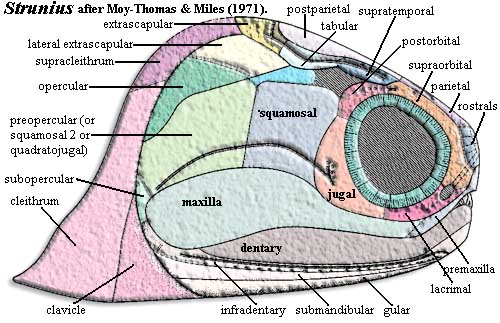 present (uncertain in Onychodus) [L01]; quadratojugal absent [A73] [CA96$?] or possibly homologous to "squamosal" [L01]; single squamosal [SA87]; 1-2 preoperculars which are broad, tall elements [L01] (compare [CA96]: large & oriented horizontally); opercular series reduced [CA96] [2]; braincase in several ossifications [A73]; otico-occipital region partially or completely unossified [L01]; otic region elongate [A73]; intracranial joint present [CA96]; intracranial joint angled at ~45° [L01]; intracranial joint passes through trigeminal foramen [L01]; very large, transversely open carotid foramina [L01]; short, broad ethmosphenoid with widely flaring buttresses extending to premaxillaries [L01]; well-developed internasal ridge with remainder of anteroventral ethmosphenoid absent [L01]; ethmoid region reduced [A73]; nasal capsules extremely small [A73]; portion of posteroventral nasal capsule unossified [A73]; single-headed hyomandibula [L01]; choana "almost certainly absent" [A73]; very short, diamond-shaped, ventrally expanded parasphenoid [L01]; 2 pairs of dermopalatine elements [A73]; 4+ ectopterygoids [L01]; vomer absent or same as anterior ectopterygoid [L01]; anterior palatoquadrate articulation and possibly basipterygoid articulation [A73]; dentary long [A73]; symphysial region elevated & may be continued anteriorly as a "ram" [ZJ94]; 4-5 (5 in Psarolepis) coronoids which may fuse with dentary [L01]; 4 infradentaries [A73] [L01] (compare [CA96] [2]: large infradentary bordering dentary ventrally); postsymphysial "retractor pit" for retraction of tooth whorl [L01]; submandibular series instead of branchiostegal rays (then, is there really a gular?) [L01]; no median gular [A73]; very large parasymphysial tooth whorls (in Onychodus, so large that it must be retracted to close the mouth) [CA96$?] [L01]; large teeth on tooth spirals sigmoid [CA96] [2]; large teeth on tooth spirals with striated or crenulated enamel [S73] [CA96] (contra [ZJ94]: early unnamed form without striated enamel); but teeth without plicidentine [A73] [SA87] [ZJ94]; marginal teeth with swollen bases & narrow tips [MM71] [ZJ94]; no small teeth on tooth spiral [S73] (contra [MM71]: small teeth may be present, but fewer than in porolepiforms); notochord unconstricted [A73]; ribs absent [A73]; tail diphyceral [A73]; fin & pectoral spines absent [L01]; cleithrum large with strong, tapering dorsal process extending far dorsally [Z+99] [L01]; interclavicle absent [A73] [CA96] [2]; pectoral fin positioned more dorsally than in most other groups [L01]; scapulocoracoid attached to inner cleithrum over broad, single attachment area [A73]; paired fin lobes short [A73]; limb axis uniserial [A73]; fin rays numerous, branched & jointed [A73]; scales thin, cycloid, without internal attachment boss [A73]; sensory canal pores small & numerous [A73].
present (uncertain in Onychodus) [L01]; quadratojugal absent [A73] [CA96$?] or possibly homologous to "squamosal" [L01]; single squamosal [SA87]; 1-2 preoperculars which are broad, tall elements [L01] (compare [CA96]: large & oriented horizontally); opercular series reduced [CA96] [2]; braincase in several ossifications [A73]; otico-occipital region partially or completely unossified [L01]; otic region elongate [A73]; intracranial joint present [CA96]; intracranial joint angled at ~45° [L01]; intracranial joint passes through trigeminal foramen [L01]; very large, transversely open carotid foramina [L01]; short, broad ethmosphenoid with widely flaring buttresses extending to premaxillaries [L01]; well-developed internasal ridge with remainder of anteroventral ethmosphenoid absent [L01]; ethmoid region reduced [A73]; nasal capsules extremely small [A73]; portion of posteroventral nasal capsule unossified [A73]; single-headed hyomandibula [L01]; choana "almost certainly absent" [A73]; very short, diamond-shaped, ventrally expanded parasphenoid [L01]; 2 pairs of dermopalatine elements [A73]; 4+ ectopterygoids [L01]; vomer absent or same as anterior ectopterygoid [L01]; anterior palatoquadrate articulation and possibly basipterygoid articulation [A73]; dentary long [A73]; symphysial region elevated & may be continued anteriorly as a "ram" [ZJ94]; 4-5 (5 in Psarolepis) coronoids which may fuse with dentary [L01]; 4 infradentaries [A73] [L01] (compare [CA96] [2]: large infradentary bordering dentary ventrally); postsymphysial "retractor pit" for retraction of tooth whorl [L01]; submandibular series instead of branchiostegal rays (then, is there really a gular?) [L01]; no median gular [A73]; very large parasymphysial tooth whorls (in Onychodus, so large that it must be retracted to close the mouth) [CA96$?] [L01]; large teeth on tooth spirals sigmoid [CA96] [2]; large teeth on tooth spirals with striated or crenulated enamel [S73] [CA96] (contra [ZJ94]: early unnamed form without striated enamel); but teeth without plicidentine [A73] [SA87] [ZJ94]; marginal teeth with swollen bases & narrow tips [MM71] [ZJ94]; no small teeth on tooth spiral [S73] (contra [MM71]: small teeth may be present, but fewer than in porolepiforms); notochord unconstricted [A73]; ribs absent [A73]; tail diphyceral [A73]; fin & pectoral spines absent [L01]; cleithrum large with strong, tapering dorsal process extending far dorsally [Z+99] [L01]; interclavicle absent [A73] [CA96] [2]; pectoral fin positioned more dorsally than in most other groups [L01]; scapulocoracoid attached to inner cleithrum over broad, single attachment area [A73]; paired fin lobes short [A73]; limb axis uniserial [A73]; fin rays numerous, branched & jointed [A73]; scales thin, cycloid, without internal attachment boss [A73]; sensory canal pores small & numerous [A73].
Notes: [1] Long (2001) is unclear on whether Psarolepis (and, by extension, Achoania?) is an onychodontiform, a more basal stem sarcopterygian, or is a sister species. The answer will depend to some extent on what definitions are used for Sarcopterygii and Onychodontiformes. In any event, he promises much more detailed descriptions in the near future. [2] These characters from [CA96] are attributed to Aquesbi, N (1988), Étude d'un Onychodontiforme (Osteichthyes, Sarcopterygii) du Dévonien moyen (Eifelian) du Maroc. Bull. Mus. Nat'l. Hist. Nat. [sér. 4] 10: 181-196.
Image: (left) Strunius from Science in Africa
Links: crossopterygii.htm; The Lineage of the Coelacanth - is there a link between ...
Andrews 1973) [A73]; Cloutier & Ahlberg (1996) [CA96], Long (2001) [L01], Moy-Thomas & Miles (1971); [MM71], Schultze (1973) [S73], Schultze & Arsenault (1987) [SA87], Zhu & Janvier (1994) [ZJ94], Zhu et al. 1999) [Z+99].
ATW040328.
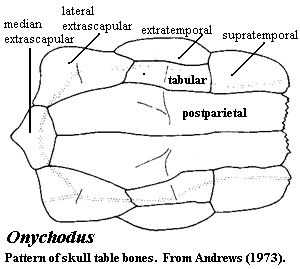 Onychodus: O. sigmoides
Onychodus: O. sigmoides
Range: Late Devonian, cosmopolitan
Phylogeny: Onychodontiformes : Strunius + *.
Characters: to 2m [L95]; skull strongly kinetic [L95]; premaxilla with medially projecting lamina of bone (under the rostral small bones?) [L01]; anterior nares opens between anterior tectal & lateral rostral [L01]; maxilla tall [S73]; maxilla with large postorbital blade (as in actopterygians) [L95]; uncertain whether eyestalk present [L01]; 3 infraorbitals [L95]; preopercular divided into preopercular and squamosal [L01]; squamosal & preopercular of similar size [L95]; quadratojugal absent [L01]; oticoccipital region unossified except for parachordal elements [L01]; well-developed intracranial joint [L95]; intracranial joint slanted, running through trigeminal foramen anteroventrally at
~45° [L01]; basipterygoid probably reduced [A73]; sphenethmoid with long anterolateral buttress to premaxilla [L01]; sphenethmoid with large, open internal carotid foramina posterior to parasphenoid [L01]; sphenethmoid 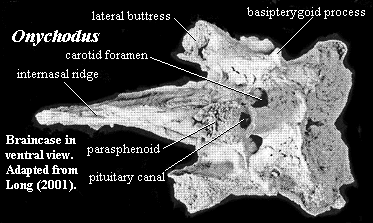 with long, thin internasal ridge flanked by large internasal cavities for tooth whorls [L01]; vomer absent, not recovered, or present as anteriormost ectopterygoid [L01]; short, dorsoventrally deep, rhomboidal parasphenoid [L01];
4 ectopterygoids [L01]; postsymphysial pit for ligament to retract tooth whorls [L01]; probably 4+ coronoids (fused to dentary) [L01]; 4 infradentaries [L01]; submandibular series replace branchiostegal rays [L01]; maxillary teeth covered by outer lamella of maxilla in lateral view [S73]; tooth whorls very large & must be retracted for mouth to close [L01]; single-headed hyomandibula [L01]; dorsal fins placed far posterior [L95]; head of cleithrum tall & pointed [L01]; humerus large & robust [L95]; no cosmine [A73].
with long, thin internasal ridge flanked by large internasal cavities for tooth whorls [L01]; vomer absent, not recovered, or present as anteriormost ectopterygoid [L01]; short, dorsoventrally deep, rhomboidal parasphenoid [L01];
4 ectopterygoids [L01]; postsymphysial pit for ligament to retract tooth whorls [L01]; probably 4+ coronoids (fused to dentary) [L01]; 4 infradentaries [L01]; submandibular series replace branchiostegal rays [L01]; maxillary teeth covered by outer lamella of maxilla in lateral view [S73]; tooth whorls very large & must be retracted for mouth to close [L01]; single-headed hyomandibula [L01]; dorsal fins placed far posterior [L95]; head of cleithrum tall & pointed [L01]; humerus large & robust [L95]; no cosmine [A73].
Links: 233.htm; AAP- nomen nudum 28, Research Reports- Australian National ...; Devonian Shales; DEVONIANO peixes sarcopterígios; 337.htm.
References: Andrews (1973) [A73]; Long (1995) [L95]; Long 2001) [L01], Schultze (1973) [S73]. ATW040313.
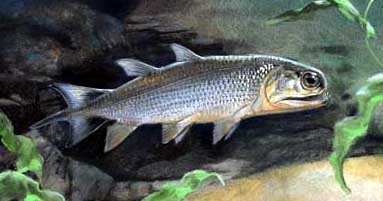 Strunius: Jessen. S. walteri Jessen, 1966; S. rolandi Gross, 1936.
Strunius: Jessen. S. walteri Jessen, 1966; S. rolandi Gross, 1936.
Range: Late Devonian (Frasnian) of Europe (Germany & Latvia) [CA96].
Phylogeny: Onychodontiformes : Onychodus + *.
Characters: ~10 cm total length [MM71]; maxilla very thin [S73]; ~18 sclerotic plates [MM71]; extratemporal absent [S73]; single squamosal [S73]; dentary with bulging thickened & projecting symphysis [S73]; left dentary overlaps right at the ventral part of the symphysis [ZS97]; body deep [MM71]; unpaired fins without basal lobes [MM71]; anal fin & 2 dorsal fins located posteriorly [MM71]; caudal fin symmetrical with large epi- & hypochordal lobes [MM71]; caudal fin with long axial lobe [MM71]; lepidotrichia unjointed & numerous [MM71]; occasional patches of cosmine [A73].
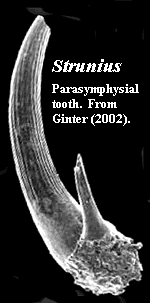 Image: Strunius kurshi from Enciklopedija "Latvijas Daba"
Image: Strunius kurshi from Enciklopedija "Latvijas Daba"
Links: 338.htm; Izmirusi Devona fauna;
References: Andrews (1973) [A73]; Cloutier & Ahlberg (1996) [CA96], Moy-Thomas & Miles (1971); [MM71], Ginter (2002); Schultze (1973) [S73], Zhu & Schultze (1997) [ZS97]. ATW040321.
checked ATW041103